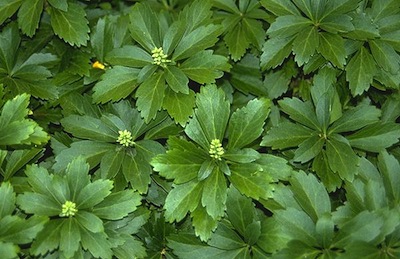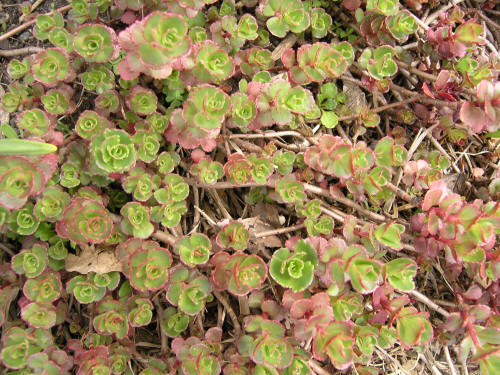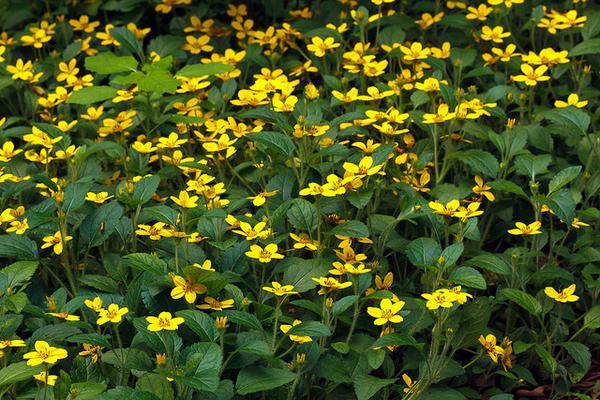Groundcovers: Lush Carpet For Your Garden
by Elaine Homstad, Fairfax Master Gardener

Pachysandra
Perhaps the conditions are not right for turf grass — they are too shady, too dry, too moist, or under large trees with massive root systems. Perhaps the regular maintenance requirements — mowing a steep slope, for instance — seem like too much of a chore. For these situations, many gardeners, landscapers and homeowners turn to the wide array of non-turf grass plants in the category of “groundcovers.”
Purpose of a groundcover
By definition, a groundcover is a low-growing plant that spreads to form a dense cover. While these plants can range in height from just a few inches to 2 or more feet, the most desirable quality in a groundcover is the density of the plant mass. Almost equal to this is the ability of the plants to retain their foliage throughout the entire year.
A groundcover plant serves a very practical purpose, in addition to providing a pleasing “living duvet” to cover bare soil. It prevents erosion, particularly on slopes, helps to inhibit weeds, provides a habitat for insects and other creatures, and provides bio-diversity in the landscape, rather than a reliance on a mono-cultural environment of turf grass.
Choosing a groundcover
The first rule of choosing any plant to include in a landscape is “Right Plant, Right Place.” This is particularly true in the case of choosing a groundcover, since its very purpose is to thrive and spread. You also want to be sure that you are not choosing a plant that will overtake beds or other areas where you do not want it. Therefore, you must first assess the conditions where you will be growing the groundcover.

Creeping Juniper
What about soil moisture and composition? Wet? Dry? Good or poor drainage? Sandy soil? Clay? Rich, loamy soil?
What is the location geography? Is it level or sloped? If sloped, by how much? What other plants are located nearby? Trees? Shrubs? Is it an area that will encounter foot traffic? What is the size of the area to be covered, and how quickly do you want it to happen?
Does it need to be deer resistant?
Once you answer those questions, you will want to determine what you would like to see in a groundcover. Remember, it is something you (and your neighbors) will be seeing year round in what could potentially be a good-sized area.
Do you want something evergreen? Would you like it to have a flowering period? How tall (or short) do you want it to be? What type of foliage or color variations do you want?

Stonecrop ‘Dragon’s Blood’ Sedum
Varieties of groundcovers
The groundcovers most often seen at garden centers are the low-growing ones, such as Pachysandra (Pachysandra procumbens or Pachysandra terminalis), Myrtle or Periwinkle (Vinca minor), Bugleweed (Ajuga reptans) and, unfortunately, English Ivy (Hedera helix). But the easy availability of these plants does not necessarily make them the best choice. Although some garden centers have stopped carrying Hedera helix, due to its highly invasive nature, it can still not only be found, but actually recommended by some less informed garden publications or websites. And while there are other types of ivy, it is wisest to avoid them entirely, in favor of one of the other plants mentioned.
Another great category is low-growing spreading evergreens, such as the varieties of creeping Junipers, which are excellent for strongly sunlit areas, edges of hard surfaces such as driveways or sidewalks, or steep slopes, and come in a variety of shades and variations.
Another group that is particularly well-suited to those hot, dry spots are the Stonecrop varieties (Sedum spp.). These fleshy-leaved plants are highly drought-tolerant and come in an array of interesting shapes and colors, some with flowers.
If a mass of flowers is something you are looking for, you can find that in Creeping Phlox (Phlox subulata), or Candytuft (Iberis sempervirens). Other groundcovers also produce flowers, but not in the same profusion as these.

Chrysogonum virginianum
For fragrance, as well as a “walkable” groundcover, thymes (Thymus spp.) are a winner. With their ground-hugging durability, they provide a release of scent when stepped on, and spring back readily.

Creeping Thyme, Thymus praecox
Planting and care
As with any plant, preparing the soil for it is important. A weed-free, loosely-packed and well-draining area, with amendments added if needed, will provide an environment in which the groundcover will thrive and spread.
Although planting can be done at any time that the soil is workable, as with most perennials, fall is an ideal planting time.
The number of plants you choose to place is dependent on not just the plant’s ultimate size and spacing requirements, but also on how quickly you want the area to fill in.
Newly planted areas should always receive adequate water, so be sure to provide it regularly during their first year.
Once established, a groundcover area needs little, if any, maintenance, though some may benefit from occasional pruning or shearing. Learn the requirements of the plants you choose to best know how to properly maintain them.
Resources
• Selecting Landscape Plants: Groundcovers, Virginia Cooperative Extension
• Groundcovers, Clemson Cooperative Extension
• Natives Alternatives to English Ivy, Virginia Native Plant Society
• Juniper Groundcovers, Clemson Cooperative Extension
• Periwinkle, Clemson University Cooperative Extension